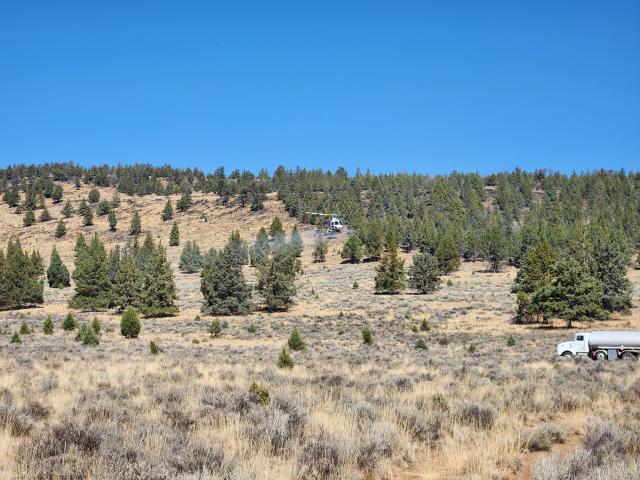BLM to combat invasive grasses with aerial herbicide treatments
LAKEVIEW, Ore. – This fall, The Bureau of Land Management will conduct aerial herbicide applications to reduce the spread of invasive annual grasses and wildfire threat across about 12,000 acres of lands managed by the BLM. From Aug. 11 to Dec. 31, the BLM will treat areas in Lake and Klamath counties, shielding communities and improving wildlife habitat by restoring native plants and reducing flashy fuels that increase wildfire threat.
“Invasive annual grasses are one of the most serious threats to the health of our public lands in eastern Oregon,” said Todd Forbes, Lakeview District Manager. “These aerial treatments are a critical tool in our efforts to restore resilient native plant communities, reduce wildfire risk, and support long-term rangeland health. We appreciate the public’s awareness and cooperation as we carry out this important work.”
Areas treated in Lake County:
- Road 157 Fire (2024) – East Lava Field Wilderness Study Area
- Bowman Well Fire (2024) –10 miles northwest of Christmas Valley
- Tucker Hill Fire (2024) –13 miles southeast of Paisley, west of OR-31
- Warner Peak Fire (2024) – Units south of Hart Mountain National Antelope Refuge near Wool and May Lakes (in partnership with U.S. Fish and Wildlife Service)
- Picture Rock Pass – Between Silver Lake and Summer Lake, east of OR-31
- North Warners – Between OR-140 and Plush Cutoff Road, west of the Fish Creek Rim Wilderness Study Area, including one unit south of Honey Creek
- Clover Flat –7 miles west of Valley Falls
Areas treated in Klamath County:
- Windy Ridge –5 miles southeast of Dairy
- Lorella –2 miles north of Lorella
- Lower Midway and Horsecamp Rim – less than 10 miles southeast of Gerber Reservoir
A combination of fixed-wing and rotor-wing aircraft will be used to apply herbicides, depending on site conditions. These treatments target invasive species such as cheatgrass (Bromus tectorum), medusahead rye (Taeniatherum caput-medusae), and North Africa grass (Ventenata dubia), which can outcompete native vegetation and lead to grass-dominated landscapes more vulnerable to wildfires.
The herbicides planned for use include Imazapic, a pre-emergent, selective herbicide, and Glyphosate, a non-selective, post-emergent herbicide that may be used where needed. Because most native perennial grasses and forbs are dormant this time of year, they are generally unaffected by these applications.
Signs will be posted at roads entering active project areas. Each site may take up to two weeks to treat, depending on weather conditions. The BLM encourages the public to avoid camping or traveling through areas during active operations to allow crews to complete treatments safely and efficiently.
For more information, contact Oliver Liu, Invasive Annual Grass Fuels Specialist, at 541-576-9416, or Kerry Johnston, Botanist, at 541-885-4136.
The BLM manages about 245 million acres of public land located primarily in 12 western states, including Alaska, on behalf of the American people. The BLM also administers 700 million acres of sub-surface mineral estate throughout the nation. Our mission is to sustain the health, diversity, and productivity of America’s public lands for the use and enjoyment of present and future generations.

